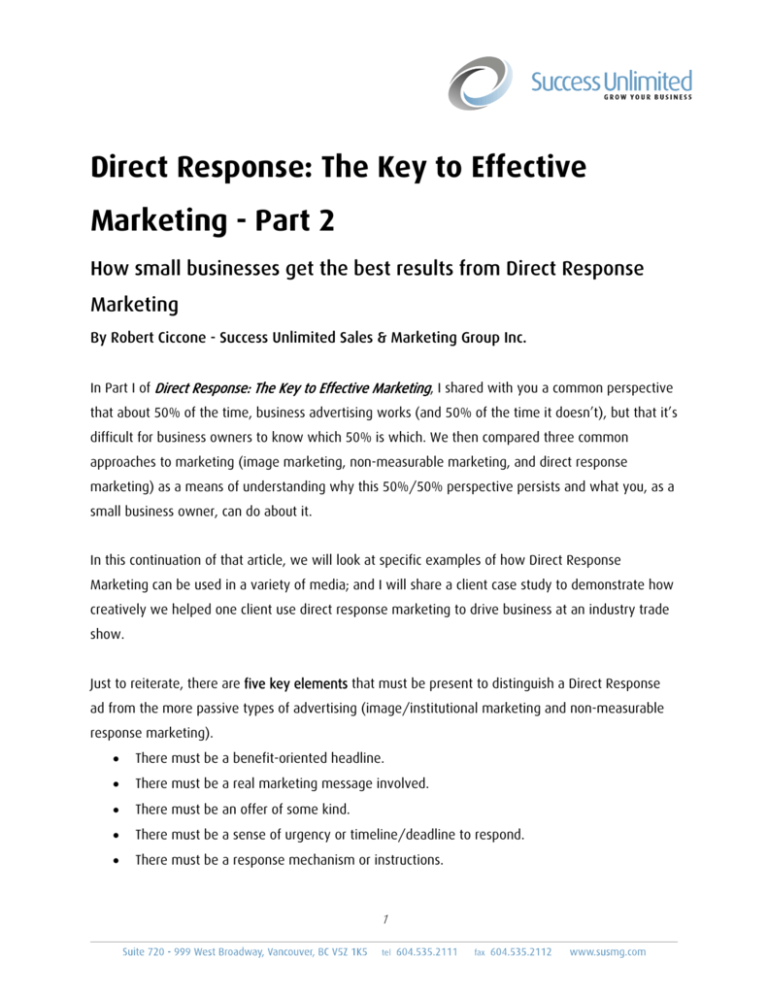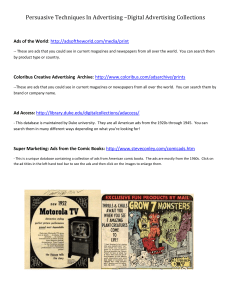
Direct Response: The Key to Effective
Marketing - Part 2
How small businesses get the best results from Direct Response
Marketing
By Robert Ciccone - Success Unlimited Sales & Marketing Group Inc.
In Part I of Direct Response: The Key to Effective Marketing, I shared with you a common perspective
that about 50% of the time, business advertising works (and 50% of the time it doesn’t), but that it’s
difficult for business owners to know which 50% is which. We then compared three common
approaches to marketing (image marketing, non-measurable marketing, and direct response
marketing) as a means of understanding why this 50%/50% perspective persists and what you, as a
small business owner, can do about it.
In this continuation of that article, we will look at specific examples of how Direct Response
Marketing can be used in a variety of media; and I will share a client case study to demonstrate how
creatively we helped one client use direct response marketing to drive business at an industry trade
show.
Just to reiterate, there are five key elements that must be present to distinguish a Direct Response
ad from the more passive types of advertising (image/institutional marketing and non-measurable
response marketing).
•
There must be a benefit-oriented headline.
•
There must be a real marketing message involved.
•
There must be an offer of some kind.
•
There must be a sense of urgency or timeline/deadline to respond.
•
There must be a response mechanism or instructions.
1
Examples of Direct Response Marketing (DRM) campaigns
To help you creatively brainstorm how you might leverage DRM in your business, let’s look at some
ways in which you might use direct response strategies. In every instance, the main difference
between the direct response ad and the other types of ads are that there is an offer to which the
customer must respond in a way that we can track and in a way where results can be measured.
(And remember that each ad must include all five of the key elements of the direct response
approach.)
Print Media (Newspapers, Magazines)
With print media, the ad itself becomes the response mechanism. The customer can clip and
bring in the ad to get the special offer. There could be a coupon for a specific item or service
offered at a discount. You could even list a phone number with a special code to be used
when they call in: “mention this code when you call to get an additional 5% off”.
Direct Mail
Direct mail includes coupon value packs, catalogs, post cards, letters and flyers. The mailer
might include: coupons to be redeemed at the store, an invitation to a private after-hours
sale where you have to bring in the invitation, a 2-for-1 dinner special or a discount on a
gym membership. Catalog businesses can put a special code on every catalog and ask the
customer to provide the code when they place an order, to track effectiveness of every
mailing.
Radio and TV Commercials
To turn your usual radio and TV ads into direct response ads, ask the customer to mention the
station’s call letters to take advantage of your advertised offer, or provide a special code or
telephone number they can use when they call.
2
Yellow Pages Ads
Ever see a yellow pages ad where the ad says “mention this ad and get $25 off your first
purchase” or something similar? How about offering a free report in your yellow page ad?
We helped one client, a promotional products company, do this with great success: “Do not
spend a dime on promotional products until you get our free report… Call today for your free
copy!” Anyone who calls for this free report, the company knows has called because they
read the yellow pages ad.
Internet Advertising
The Internet presents a whole new area of direct response marketing opportunities. On your
web site: “sign up for this mailing list and get a free report”. If you are using click-through
banner ads or pay-per-click ads, make sure there is a way you can track and measure results
from each ad so you know where your web site traffic and on-line sales are coming from.
If you are using several different types of direct response ads (two different print ads plus a direct
mail flyer, for instance), put a unique identifying code on each one so you can distinguish between
them when the customers respond, and find out which are having the most impact.
In everything you do with your marketing and advertising, you can ask for some kind of response
from the customer. When you get the response, you have the ability to measure and track
effectiveness of each ad and can determine if you are spending your marketing dollars wisely. Ask
yourself: with this ad, can I measure the results? Does it have all of the five elements that make this
a direct response ad? As you develop your advertising, keep coming back to the five points as your
guide.
A Case Study: Direct Response Marketing in Action
Once you begin to see all your advertising efforts in terms of direct response marketing, any
communications with your customer base can be done with an eye toward direct response as a
3
measurement tool. We helped one of our clients turn a trade show “visit our booth” invitation into a
direct response opportunity.
The client, a building industry company that manufactures doors, went to a national trade show.
Using their database of clients and prospective clients, we sent out a mailing in advance of the show
to entice people to visit the client’s booth. Now, the usual such mailing most companies send out
would be a postcard or a flyer with a brief invitation to “visit us at booth #123, and we hope to see
you there.”
We wanted this client to turn this trade show into a powerful and measurable marketing
opportunity. We turned the usual invitation into a 2-page sales letter that incorporated all of the five
elements of direct response marketing.
The benefit-oriented headline was: “Visit our booth and we’ll show you how to save thousands of
dollars on value added services for the finest crafted wood doors available!” The marketing message
was woven all throughout the letter, and included some of the company’s history as fine craftsmen
of wood doors and feedback from happy customers.
The specific offer, timeline, and response mechanism was: “Visit our booth, present this letter, and
meet with one of our representatives. If that discussion results in the eventual order of 20 doors or
more within 90 days of the show, we will give you 50% off the pre-finishing of your initial order.”
With this letter in hand, interested customers were able to stop at the booth to find out more about
this company’s products. The company was able to track how many potential customers visited their
booth for a conversation with a sales rep, and from there, could track which of them brought along
the sales letter and which of those conversations progressed into an actual sale. The company could
measure, to the dollar, how much they spent on the entire campaign and whether or not it was
successful in relation to the sales that resulted. They were able to make decisions about future
marketing efforts and whether it would be worth attending this particular trade show next year.
4
The consistent value of Direct Response Marketing
When you have this kind of specific information available to you, it’s easy to see how valuable it is in
managing your entire marketing and advertising strategy. Instead of constant “hit or miss”
experimentation in your advertising strategy, you can determine which ads are performing well,
which elements can be tested and improved, and which media venues truly help you attract the
most sales. You can direct your marketing budget to the activities where you know, for certain, that
you are getting the most value for your dollars. If one ad or media venue doesn’t seem to be
performing well, you can make adjustments to the ad message or even decide to cease future such
advertising altogether, and channel that money into the marketing efforts that work.
As I said earlier, the image marketing approach definitely has its place. The issue is that small
business owners cannot afford to waste money on non-measurable implementation. Yes, go ahead
and buy the ad, but make it measurable. I would rather see marketing dollars spent where results
can be accurately measured and where tests can be conducted to help further refine and improve
the response levels of future marketing investments. To do this, Direct Response Marketing is the
key to success.
Copyright ©2007 Robert Ciccone. All rights reserved. For reprint permission, contact info@susmg.com
________________________________________________________________________________
About the Author
Robert Ciccone is the president and founder of Success Unlimited Sales and Marketing Group
www.susmg.com, an applied marketing consulting firm that helps companies increase their sales
and profits. He can be reached at 604-688-7733 or rob@SUSMG.com.
5









